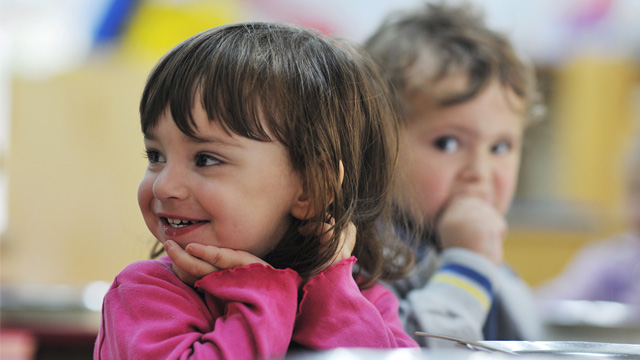 Data from the 2014 Head Start Family and Child Experiences Survey (FACES 2014) reveal that children enrolled in the program experience gains in both English receptive and expressive vocabulary, letter-word knowledge, and early math, but show no gains in early writing skills over the program year. Children who are dual language learners—one quarter of Head Start’s enrollment—experience challenges, and some strengths, which often differ from the experiences of other children in the program. For example, they are more likely to live with both of their biological or adoptive parents and with at least one parent who is employed. However, about one-third have parents who report food insecurity. Detailed information about dual language learners can help program administrators better understand, and adjust to, the needs of this population.
Data from the 2014 Head Start Family and Child Experiences Survey (FACES 2014) reveal that children enrolled in the program experience gains in both English receptive and expressive vocabulary, letter-word knowledge, and early math, but show no gains in early writing skills over the program year. Children who are dual language learners—one quarter of Head Start’s enrollment—experience challenges, and some strengths, which often differ from the experiences of other children in the program. For example, they are more likely to live with both of their biological or adoptive parents and with at least one parent who is employed. However, about one-third have parents who report food insecurity. Detailed information about dual language learners can help program administrators better understand, and adjust to, the needs of this population.
Funded by the U.S. Department of Health and Human Services, Administration for Children and Families, Office of Planning, Research, and Evaluation, FACES 2014 collects extensive data about children and families served by Head Start programs nationally. Mathematica led this data collection and has used FACES 2014 data to study issues such as family engagement and child development as well as characteristics of dual language learners. Results are summarized in a series of new technical reports and research briefs. Mathematica’s analysis provides a fundamental understanding of the population served by Head Start, which is key to delivering responsive, high quality program services.
Learn more about FACES 2014.
FACES 2014 Technical Reports and Research Briefs
A Spotlight on Dual Language Learners in Head Start: FACES 2014. This research brief provides a nationally representative description of children who are dual language learners enrolled in Head Start. About half of all dual language learners pass a language screener at the start of the year and are able to be assessed in English.
A National Portrait of Head Start Children and Families: FACES 2014. This research brief describes the characteristics, well-being, and development of children and families at the beginning of the Head Start program year. Data reveal that more than three-quarters of the children live with one or more parents with at least a high school diploma or GED, and around half of the children live with at least one parent who is working full time. More than three-quarters report reading to their Head Start child at least three times in the past week.
Building Family Partnerships: Family Engagement Findings from the Head Start FACES Study. This report describes parent and staff perspectives on family engagement activities and service providers in Head Start. Parents tend to report positive relationships with staff, and program staff report regular information sharing with their colleagues. Program staff may need more support for engaging with families in two areas: goal-setting for themselves and their child and support for child learning and development.
A Portrait of Head Start Classrooms and Programs in Spring 2015: FACES 2014–2015 Data Tables and Study Design. This report presents descriptive statistics about the characteristics of classrooms, teachers, centers, and programs serving Head Start children and families. Nearly three-quarters of lead teachers have a bachelor’s degree or higher. Observed instructional support within classroom settings received a low score, but classroom emotional support landed in the midrange.
Descriptive Data on Head Start Children and Families from FACES 2014: Fall 2014 Data Tables and Study Design. This report includes key information on the FACES 2014 study design and a set of data tables that presents descriptive statistics on the demographic backgrounds and developmental outcomes of children enrolled in Head Start in fall 2014. The tables also detail aspects of their home environments.
Child and Family Outcomes During the Head Start Year: FACES 2014-2015 Data Tables and Study Design. This report includes key information on the FACES 2014 study design and a set of data tables that presents descriptive statistics on the demographic backgrounds and developmental outcomes of children enrolled in Head start in fall 2014 who were still enrolled in spring 2015. The tables also detail aspects of their home environments.

